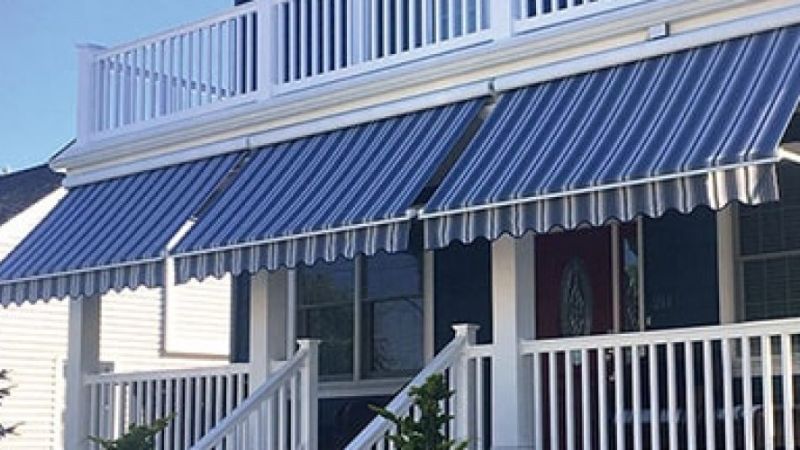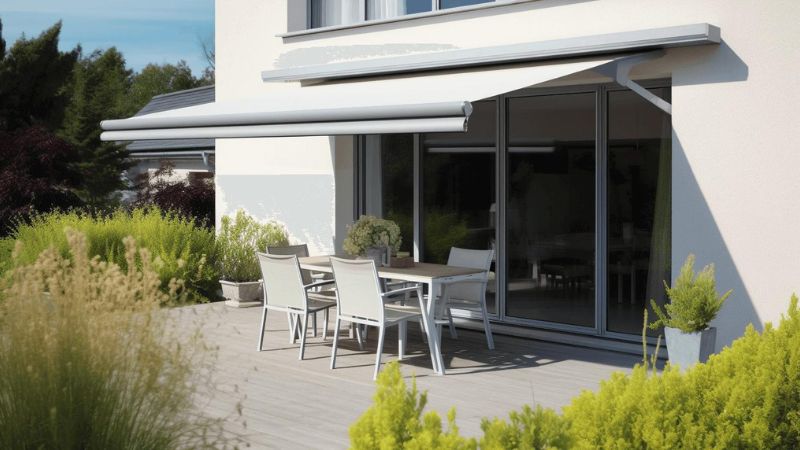Awnings are a great addition to any home or business, offering shade, comfort, and style. However, constant exposure to the sun can lead to wear and tear, fading, and weakening of the material over time. If not properly cared for, sun damage can reduce the lifespan of your awnings, leading to costly replacements.
Learning how to protect awnings from sun damage is essential to maintain their durability and appearance. This guide will provide practical tips and preventive measures to help safeguard your awnings, ensuring they remain vibrant and functional for years to come.
How To Protect Awnings From Sun Damage?
1. Choose UV-Resistant Materials for Your Awnings
One of the most effective ways to protect your awnings from sun damage is to invest in UV-resistant materials. Not all fabrics are created equal when it comes to withstanding harsh sunlight. Acrylic and vinyl fabrics are popular options because of their durability and resistance to ultraviolet rays. Acrylic is breathable, helping to prevent mold and mildew while offering a good level of sun protection. Vinyl, on the other hand, is waterproof and offers excellent UV resistance, making it suitable for areas with intense sun exposure. When selecting an awning, check for UV resistance ratings, as higher-rated fabrics will last longer and provide better protection from the sun’s harmful rays.
Choosing the right material not only reduces fading and discoloration but also enhances the overall lifespan of your awnings. Fabrics that are specifically treated for UV protection ensure that your awnings retain their vibrant colors and strength over time. Regular exposure to the sun without this protection can cause fabrics to degrade, leading to brittleness and tearing. By opting for UV-resistant materials, you’re making a long-term investment in the durability and aesthetic appeal of your outdoor spaces.
Also Read:- Tips To Keep Your Awning Looking Brand New
2. Apply UV-Protectant Sprays
Even if your awning material is UV-resistant, applying additional UV-protectant sprays can significantly enhance its ability to withstand prolonged sun exposure. These sprays form a protective layer on the fabric, acting as a shield against harmful UV rays. Most UV-protectant sprays are easy to apply and are designed for outdoor use, making them ideal for protecting awnings, patio furniture, and other fabric-based outdoor accessories. It’s important to apply these sprays at least once a year, preferably before the peak of the summer season when the sun’s intensity is at its highest.
UV-protectant sprays also help in maintaining the flexibility and strength of the awning fabric. Over time, sunlight can weaken fabric fibers, causing them to become brittle and prone to tearing. By applying UV protectants, you reduce the rate of wear and tear, ensuring that your awnings stay in good condition for longer. Be sure to follow the manufacturer’s instructions when using these sprays, as proper application will maximize the effectiveness of the protection.
3. Regular Cleaning and Maintenance
Regular cleaning is crucial to keeping your awnings in top shape and preventing sun damage. Dirt, debris, and pollutants can settle on the surface of the awning, making it more vulnerable to sun exposure. These particles can also trap heat, leading to accelerated degradation of the fabric. Cleaning your awnings with a mild soap solution and a soft brush or cloth will remove these impurities and allow the fabric to breathe. Avoid using harsh chemicals or power washers, as they can damage the protective coatings on the fabric.
In addition to cleaning, inspecting your awnings for any signs of wear or damage is essential. Look for any areas that may have started to fade or fray, and address them immediately. By catching small issues early, you can prevent further damage caused by sun exposure. Regular maintenance not only prolongs the life of your awnings but also ensures they remain functional and attractive throughout the year.
4. Use Retractable Awnings
Retractable awnings provide a great solution for protecting your awnings from sun damage. These types of awnings can be extended when needed for shade and retracted when not in use, reducing the amount of time they are exposed to direct sunlight. By minimizing their exposure to the sun, you reduce the wear and tear on the fabric, ensuring it remains in good condition for years. Retractable awnings are especially useful in areas with intense sun exposure or varying weather conditions.
In addition to protecting the awning itself, retractable awnings also offer flexibility in managing the sunlight in your outdoor spaces. You can adjust them as needed to control the amount of shade and light, creating a comfortable environment without putting unnecessary strain on the awning material. By investing in a retractable awning, you enhance both the longevity of the fabric and the overall functionality of your outdoor space.
5. Install Awning Covers When Not in Use
When your awnings are not in use, especially during the off-season or periods of low outdoor activity, installing protective covers can provide an additional layer of defense against sun damage. Awning covers are designed to shield the fabric from direct exposure to sunlight, dust, and other environmental elements. These covers are easy to install and remove, making them a practical solution for maintaining the quality of your awnings over time.
By using awning covers, you not only protect the fabric from UV rays but also from rain, wind, and debris that could contribute to wear and tear. Covers are particularly useful during the winter months when awnings are not in regular use, providing a safeguard against harsh weather conditions. This extra step can significantly extend the life of your awnings, keeping them in pristine condition year-round.
6. Adjust Awning Angle for Optimal Sun Protection
The angle at which your awning is positioned plays a crucial role in its ability to provide shade and protect against sun damage. A properly angled awning can block the sun’s rays more effectively, reducing the amount of direct exposure the fabric receives. When UV rays are at their highest, which is usually between 10 a.m. and 4 p.m., position the awning to cover the sun for optimal protection. An adjustable awning frame allows you to alter the angle as the position of the sun changes throughout the day.
By optimizing the angle of your awnings, you ensure that they offer the best possible protection for both the awning material and the shaded area beneath. This not only reduces the risk of sun damage to the fabric but also helps to keep your outdoor space cooler, making it more comfortable during hot summer days. Regularly adjusting the angle to match the sun’s movement is a simple yet effective way to enhance your awnings’ longevity.
Also Read:- Tips To Protect Your Awnings In Winter
7. Store Awnings Properly During Winter Months
If you live in an area where winters are harsh, it’s a good idea to remove and store your awnings during the colder months. Prolonged exposure to winter elements like snow, ice, and high winds can cause significant damage to both the fabric and the frame of the awning. Before storing, ensure that the awning is clean and dry to prevent mold or mildew from developing during storage. Tightly roll the fabric and store it out of direct sunlight in a cool, dry spot.
Proper storage not only protects your awnings from winter damage but also prolongs their overall lifespan. When you take the time to store them correctly, you’re essentially giving the fabric a break from environmental stressors, allowing it to last longer and stay in better condition. Following this tip will ensure that your awnings are ready for use when the warmer months return, without the need for costly repairs or replacements.
Conclusion
Protecting your awnings from sun damage is a simple yet effective way to extend their life and keep them looking great. By using UV-resistant coatings, regular cleaning, and retractable options, you can significantly reduce wear and tear. With these steps, your awnings will continue to provide shade and enhance your property’s aesthetic appeal.
FAQs
How can I prevent my awnings from fading in the sun?
Applying a UV-protectant spray can help reduce fading caused by sun exposure.
What is the best material for sun-resistant awnings?
Acrylic fabrics and vinyl are highly resistant to UV rays, making them ideal for sun protection.



